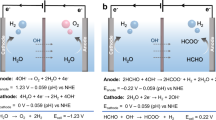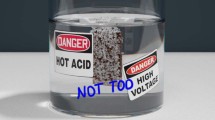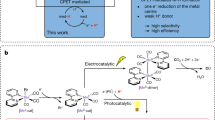Abstract
The oxidation of water to O2 is a key challenge in the production of chemical fuels from electricity. Although several catalysts have been developed for this reaction, substantial challenges remain towards the ultimate goal of an efficient, inexpensive and robust electrocatalyst. Reported here is the first copper-based catalyst for electrolytic water oxidation. Copper–bipyridine–hydroxo complexes rapidly form in situ from simple commercially available copper salts and bipyridine at high pH. Cyclic voltammetry of these solutions at pH 11.8–13.3 shows large, irreversible currents, indicative of catalysis. The production of O2 is demonstrated both electrochemically and with a fluorescence probe. Catalysis occurs at about 750 mV overpotential. Electrochemical, electron paramagnetic resonance and other studies indicate that the catalyst is a soluble molecular species, that the dominant species in the catalytically active solutions is (2,2′-bipyridine)Cu(OH)2 and that this is among the most rapid homogeneous water-oxidation catalysts, with a turnover frequency of ~100 s−1.
This is a preview of subscription content, access via your institution
Access options
Subscribe to this journal
Receive 12 print issues and online access
$259.00 per year
only $21.58 per issue
Buy this article
- Purchase on Springer Link
- Instant access to full article PDF
Prices may be subject to local taxes which are calculated during checkout





Similar content being viewed by others
References
Eisenberg, R. & Gray, H. B. Preface on making oxygen. Inorg. Chem. 47, 1697–1699 (2008).
Sala, X., Romero, I., Rodríguez, M., Escriche, L. & Llobet, A. Molecular catalysts that oxidize water to dioxygen. Angew. Chem. Int. Ed. 48, 2842–2852 (2009).
Hurst, J. K. Chemistry in pursuit of water oxidation catalysts for solar fuel production. Science 328, 315–316 (2010).
US Department of Energy. Report of the Basic Research Needs for Solar Energy Utilization 38–46, 135–183, (2005); http://science.energy.gov/~/media/bes/pdf/reports/files/seu_rpt.pdf.
McEvoy, J. P. & Brudvig, G. W. Water-splitting chemistry of photosystem II. Chem. Rev. 106, 4455–4483 (2006).
Trassati, S. in The Electrochemistry of Novel Materials (eds Lipkowski, J. & Ross, P. N.) Ch. 5, 207–296 (VCH, 1994).
McAlpin, J. G. et al. Electronic structure description of a [Co(III)3Co(IV)O4] cluster: a model for the paramagnetic intermediate in cobalt-catalyzed water oxidation. J. Am. Chem. Soc. 133, 15444–15452 (2011).
Gorlin, Y. & Jaramillo, T. F. A bifunctional nonprecious metal catalyst for oxygen reduction and water oxidation. J. Am. Chem. Soc. 132, 13612–13614 (2010).
Concepcion, J. J. et al. Making oxygen with ruthenium complexes. Acc. Chem. Res. 42, 1954–1965 (2009).
Tseng, H. W., Zong, R., Muckerman, J. T. & Thummel, R. Mononuclear ruthenium(II) complexes that catalyze water oxidation. Inorg. Chem. 47, 11763–11773 (2008).
Dismukes, G. C. et al. Development of bioinspired Mn4O4-cubane water oxidation catalysts: lessons from photosynthesis. Acc. Chem. Res. 42, 1935–1943 (2009).
Ellis, W. C., McDaniel, N. D., Bernhard, S. & Collins, T. J. Fast water oxidation using iron. J. Am. Chem. Soc. 132, 10990–10991 (2010).
Lalrempuia, R., McDaniel, N. D., Muller-Bunz, H., Bernhard, S. & Albrecht, M. Water oxidation catalyzed by strong carbene-type donor–ligand complexes of iridium. Angew. Chem. Int. Ed. 49, 9765–9768 (2010).
Wasylenko, D. J., Ganesamoorthy, C., Borau-Garcia, J. & Berlinguette, C. P. Electrochemical evidence for catalytic water oxidation mediated by a high-valent cobalt complex. Chem. Commun. 47, 4249–4251 (2011).
Schley, N. D. et al. Distinguishing homogeneous from heterogeneous catalysis in electrode-driven water oxidation with molecular iridium complexes. J. Am. Chem. Soc. 133, 10473–10481 (2011).
Duan, L. et al. A molecular ruthenium catalyst with water-oxidation activity comperable to that of photosystem II. Nature Chem. 4, 418–423 (2012).
Lewis, E. A. & Tolman, W. B. Reactivity of dioxygen, μ-copper systems. Chem. Rev. 104, 1047–1076 (2004).
Mirica, L. M., Ottenwaelder, X. & Stack, T. D. P. Structure and spectroscopy of copper–dioxygen complexes. Chem. Rev. 104, 1013–1046 (2004).
Hayashi, H. et al. A bis(μ-oxo)dicopper(III) complex with aromatic nitrogen donors: structural characterization and reversible conversion between copper(I) and bis(μ-oxo)dicopper(III) species. J. Am. Chem. Soc. 122, 2124–2125 (2000).
Ottenwaelder, X. et al. Reversible O–O bond cleavage in copper–dioxygen isomers: impact of anion basicity. J. Am. Chem. Soc. 128, 9268–9269 (2006).
Maiti, D., Woertink, J. S., Narducci Sarjeant, A. A., Solomon, E. I. & Karlin, K. D. Copper dioxygen adducts: formation of bis(μ-oxo)dicopper(III) versus (η-1,2)peroxodicopper(II) complexes with small changes in one pyridyl-ligand substituent. Inorg. Chem. 47, 3787–3800 (2008).
Kunishita, A. et al. Reactions of copper(II)–H2O2 adducts supported by tridentate bis(2-pyridylmethyl)amine ligands: sensitivity to solvent and variations in ligand substitution. Inorg. Chem. 47, 8222–8232 (2008).
Brushett, F. R. et al. A carbon-supported copper complex of 3,5-diamino-1,2,4-triazole as a cathode catalyst for alkaline fuel cell applications. J. Am. Chem. Soc. 132, 12185–12187 (2010).
McCrory, C. C. L. et al. Electrocatalytic O2 reduction by covalently immobilized mononuclear copper(I) complexes: evidence for a binuclear Cu2O2 intermediate. J. Am. Chem. Soc. 133, 3696–3699 (2011).
Elizarova, G. L., Matvienko, L. G., Lozhkina, N. V., Maizlish, V. E. & Parmon, V. N. Homogeneous catalysts for dioxygen evolution from water. Oxidation of water by trisbipyradylruthenium(III) in the presence of metallophthalocyanines. React. Kinet. Catal. Lett. 16, 285–288 (1981).
Elizarova, G. L., Matvienko, L. G., Lozhkina, N. V., Parmon, V. N. & Zamaraev, K. I. Homogeneous catalysis for dioxygen evolution from water. Water oxidation by trisbipyridylruthenium(III) in the presence of cobalt, iron, and copper complexes. React. Kinet. Catal. Lett. 16, 191–194 (1981).
Ikeda, S. et al. Mechano-catalytic overall water splitting. Chem. Commun. 2185–2186 (1998).
de Jongh, P. E., Vanmaekelbergh, D. & Kelly, J. J. Cu2O: a catalyst for the photochemical decomposition of water? Chem. Commun. 1069–1070 (1999).
Walker, A. V. & Yates, J. T. Does cuprous oxide photosplit water? J. Phys. Chem. B 104, 9038–9043 (2000).
Harris, C. M., Sinn, E., Walker, W. R. & Woolliams, P. R. Nitrogenous chelate complexes of transition metals. V. Binuclear hydroxy-bridged copper(II) complexes of 1,10-phenanthroline and 2,2′-bipyridyl. Aust. J. Chem. 21, 631–640 (1968).
Yeager, E. Electrocatalysts for O2 reduction. Electrochim. Acta 29, 1527–1537 (1984).
Hetterscheid, D. G. H. & Reek, J. N. H. Me2-NHC based robust Ir catalyst for efficient water oxidation. Chem. Commun. 47, 2712–2714 (2011).
Yin, Q. S. et al. A fast soluble carbon-free molecular water oxidation catalyst based on abundant metals. Science 328, 342–345 (2010).
Nakagawa, T., Bjorge, N. S. & Murray, R. W. Electrogenerated IrOx nanoparticles as dissolved redox catalysts for water oxidation. J. Am. Chem. Soc. 131, 15578–15579 (2009).
Minguzzi, A., Fan, F-R. F., Vertova, A., Rondinini, S. & Bard, A. J. Dynamic potential–pH diagrams application to electrocatalysts for water oxidation. Chem. Sci. 3, 217–229 (2012).
Castro, I. et al. Synthesis, crystal structure and magnetic properties of di-μ-hydroxo-bis[(2,2′-bipyridine)(trifluoromethanesulfonato-O)-copper(II)]. J. Chem. Soc. Dalton Trans. 47–52 (1992).
Figgis, B. N., Mason, R., Smith, A. R. P., Varghese, J. N. & Williams, G. A. Spin density and structure of aquabis(2,2′-bipyridine)di-μ-hydroxosulphatodicopper(II) tetrahydrate at 4.2 K. J. Chem. Soc. Dalton Trans. 703–711 (1983).
Garribba, E., Micera, G., Sanna, D. & Strinna-Erre, L. The Cu(II)-2,2′-bipyridine system revisited. Inorg. Chim. Acta 299, 253–261 (2000).
Majeste, R. J. & Meyers, E. A. Crystal and molecular structure of bisbipyridyl-μ-dihydroxo-dicopper(II) nitrate. J. Phys. Chem. 74, 3497–3500 (1970).
Prenesti, E., Daniele, P. G., Berto, S. & Toso, S. Spectrum–structure correlation for visible absorption spectra of copper(II) complexes showing axial co-ordination in aqueous solution. Polyhedron 25, 2815–2823 (2006).
Toofan, M., Boushehri, A. & Mazhar Ul, H. Crystal and molecular structure of di-μ-hydroxo-bis[bipyridylcopper(II)] diperchlorate. J. Chem. Soc. Dalton Trans. 217–219 (1976).
Fabian, I. Hydrolytic reactions of copper(II) bipyridine complexes. Inorg. Chem. 28, 3805–3807 (1989).
Zanello, P. Inorganic Electrochemistry: Theory, Practice, and Application (Royal Society for Chemistry, 2003).
Bard, A. J. & Faulkner, L. R. Electrochemical Methods: Fundamentals and Applications 2nd edn (Wiley, 2001).
Savéant, J-M. Molecular catalysis of electrochemical reactions. Mechanistic aspects. Chem. Rev. 108, 2348–2378 (2008).
Savéant, J. M. & Vianello, E. Potential-sweep chronoamperometry: kinetic currents for first-order chemical reaction parallel to electron-transfer process (catalytic currents). Electrochim. Acta 10, 905–920 (1965).
Stracke, J. J. & Finke, R. G. Electrocatalytic water oxidation beginning with the cobalt polyoxometalate [Co4(H2O)2(PW9O34)2]10−: Identification of heterogeneous CoOx as the dominant catalyst. J. Am. Chem. Soc. 133, 14872–14875 (2011).
Gudavarthy, R. V. et al. Epitaxial electrodeposition of chiral CuO films from copper(II) complexes of malic acid on Cu(111) and Cu(110) single crystals. J. Mat. Chem. 21, 6209–6216 (2011).
Hurst, J. K., Cape, J. L., Clark, A. E., Das, S. & Qin, C. Mechanisms of water oxidation catalyzed by ruthenium diimine complexes. Inorg. Chem. 47, 1753–1764 (2008).
Waidmann, C. R. Investigating Proton Coupled Electron Transfers in Oxovanadium and Dimeric Copper-Oxo Systems: the Importance of Instrinsic Barriers and Reaction Driving Force PhD thesis, University of Washington (2009).
Acknowledgements
We thank the US National Science Foundation Center for Enabling New Technologies Through Catalysis for support. We are grateful to C. Waidmann for his studies of the oxidation of dimeric copper complexes50 that laid critical groundwork for the work reported here, and to W.B. Tolman for discussions.
Author information
Authors and Affiliations
Contributions
S.M.B. and J.M.M. conceived and designed the experiments, S.M.B. performed all the experiments, S.M.B., K.I.G. and J.M.M. analysed the data and co-wrote the paper.
Corresponding author
Ethics declarations
Competing interests
The authors declare no competing financial interests.
Supplementary information
Supplementary information
Supplementary information (PDF 1613 kb)
Rights and permissions
About this article
Cite this article
Barnett, S., Goldberg, K. & Mayer, J. A soluble copper–bipyridine water-oxidation electrocatalyst. Nature Chem 4, 498–502 (2012). https://doi.org/10.1038/nchem.1350
Received:
Accepted:
Published:
Issue Date:
DOI: https://doi.org/10.1038/nchem.1350
This article is cited by
-
Non-covalent ligand-oxide interaction promotes oxygen evolution
Nature Communications (2023)
-
Aesculus indica-derived heteroatom-doped carbon as an electrode material for super-capacitor
Carbon Letters (2023)
-
Redox-active ligands in artificial photosynthesis: a review
Environmental Chemistry Letters (2022)
-
Transition Metal Based Coordination Complexes as Catalysts for Water Oxidation
Resonance (2022)
-
Electrochemically induced nickel catalysis for oxygenation reactions with water
Nature Catalysis (2021)



